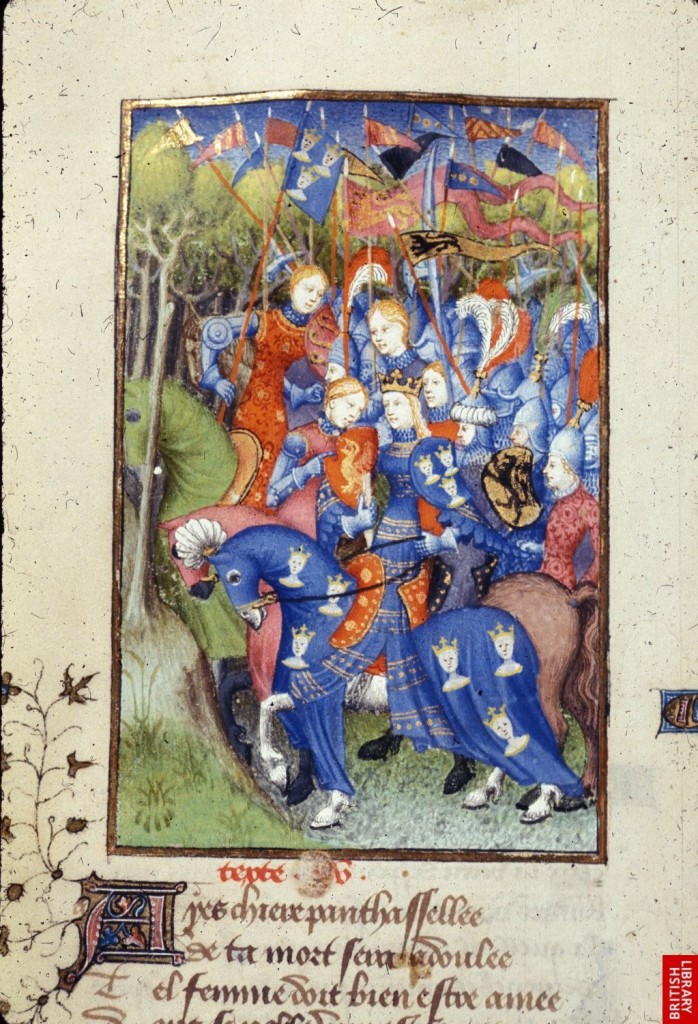
By Patrick Hunt –
In Chretien de Troyes’ 12th century chivalric tale Erec and Enide, the young knight Erec engages in a battle of honor defending Queen Guinevere but is not known by his arrogant adversary Yeder, partly because he is unadorned and wearing borrowed armor without his heraldry even though his knightly name and reputation are known to his host and future father-in-law, the kind vavasour. Even the town tournament folk do not recognize him: “”Who is yonder knight? He must be doughty and brave, indeed, to act as escort for this fair maid” (verses 748 & ff.). [1]
Fox-Davies has called heraldry as the “shorthand of history” [2]. Its complexities and often esoteric language of visual symbols articulate subtleties that many more words would be needed to cover the same details provided in an armorial image. More than a few heraldic lists from the thirteenth to fourteenth centuries, like the 13th c. Codex Manesse or the contemporary Bigot Roll of Arms, show armorial bearings without names or with garbled names added later, which supports the visual literacy aspect of heraldry as earlier than the written version. Like other periods, textual literacy in Medieval Europe is not easily deduced. Earlier in the Carolingian Renaissance of the eighth to ninth centuries, Charlemagne’s generous state sponsorship of manuscript production and monastic scriptoria created an exponential rise of reading materials, whereas in the seventh century Europe had very few people who could read or write at an adult level, some estimates suggest very low literacy, well under 0.5%, mostly monks in Benedictine or other orders, although proof of ownership was much dependent on written records that required some Latin literacy.[3] For application and a possibly comparable index of change, although much debated, even in the Golden Age of fifth century BCE Athens where sources are also scanty for estimating literacy (although some use ostraka evidence to argue against general illiteracy of citizens), any percent of the population who could be called literate would be mostly restricted to citizens rather than the bulk of the Athenian population that would include tenant farmers and slaves. It is also generally assumed that literacy was greater in the fourth century of Athens than in earlier periods, judging by the rise of schools and representations thereof in art, among other media. For modern comparison, Burns also points out that in recent recruiting, the U.S. Navy rejects abut 30% of potential recruits for functional illiteracy. [4]
Regardless of any amount of societal textual illiteracy at large, medieval heraldry has its own visual language, highly encoded and replete with references to broader history as well as familial legend. Early Renaissance artists continued the traditions of heraldry, especially as a form of visual literacy when few could read or write, but with the advent of the printing press many of these visual attributions ceased to be needed. While Carolingian seals and emblems from the ninth century onward may have had recognizable administrative symbols and even standards, many have tried in vain to assert that the c. 1077 Bayeaux Tapestry shows heraldic devices shields but this is no longer widely held. [5] It may be surprising that true heraldry with distinctive armorial bearings can only be traced back as far as the 12th century, with Geoffrey V Count of Anjou’s knighting in 1127 and his funerary imagery of gold lions on a blue field around 1151 or with Richard I’s (1157-99) gold lion rampant on his shield in 1189. Richard I’s blazon is followed about a decade later with the now familiar three gold lions on a red shield used ever since for England’s heraldry, formally noted as the first royal blazon of Gules tre lions passant guardant in pale Or armed and langued Azure, using Norman French to say a “red shield (Gules) with three gold (Or) guarding lions walking but facing out toward the viewer and having blue (Azure) tongues (langued) and claws (armed).”
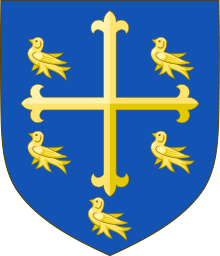
Yet others hold that the banner of Edward the Confessor (1004-66) should count as an early heraldic precursor, as it certainly predates Richard I from the mid-11th century. Edward Confessor’s banner is visually described as consisting of a patonce gold cross surrounded by five gold quartered birds and a fifth bird at bottom, as seen in the left image of Edward Confessor’s standard, which is on a shield blazon here.
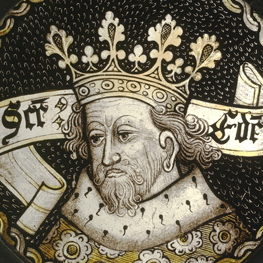
Recognizing friend from foe on the battlefield in close combat, especially when faces were covered by helmets, was crucial to survival in feudal war, one of the most important functions of heraldry, less so in the pageantry and lists of jousting tournaments but nonetheless celebrated as a colorful way to establish what would be called a marque or trademark in modern parlance. On the other hand, in the often muddy field of war when battering weapons could soon obliterate imagery, such heraldic devices would soon be moot. In the past, heraldry could be concocted by formal bodies like colleges of arms or royal patent, although many armorial bearings were self-assumed by the knights themselves, often amalgams bearing witness to the natural world as apotropaic (guarding) animals in defense of family members or visual memes of clever puns and family totems. Punning – a visual play on a word or image allusive to the family name – is also referred to as canting. Some visual name punning is very clear, others not so.
For example, the Shelley arms are three gold shells on a shield, two shells on top separated from the lower shell by a fess (horizontal bar) that is doubly invected (serrated or scalloped). Other visual puns of the armiger (“arms-bearer”) include the Hasely Family of Suffolk, where three gold hazelnuts were arranged on a silver and red shield; another is the Cockerell Family of London, with four red cocks on a gold field. Heralds eventually established the office of creating and promulgating heraldry on a forma level for noble houses, and heirs were schooled in such matters to recognize the arms of kin, friends, and foes. Even in George R.R. Martin’s Song of Ice and Fire series in the spin-off Game of Thrones episodes, young Bran Stark of Winterfell of the House of Stark is charged with memorizing such armorial details of the great houses of the Seven Kingdoms, which is a wholly realistic recreated expectation of medieval feudal tradition.
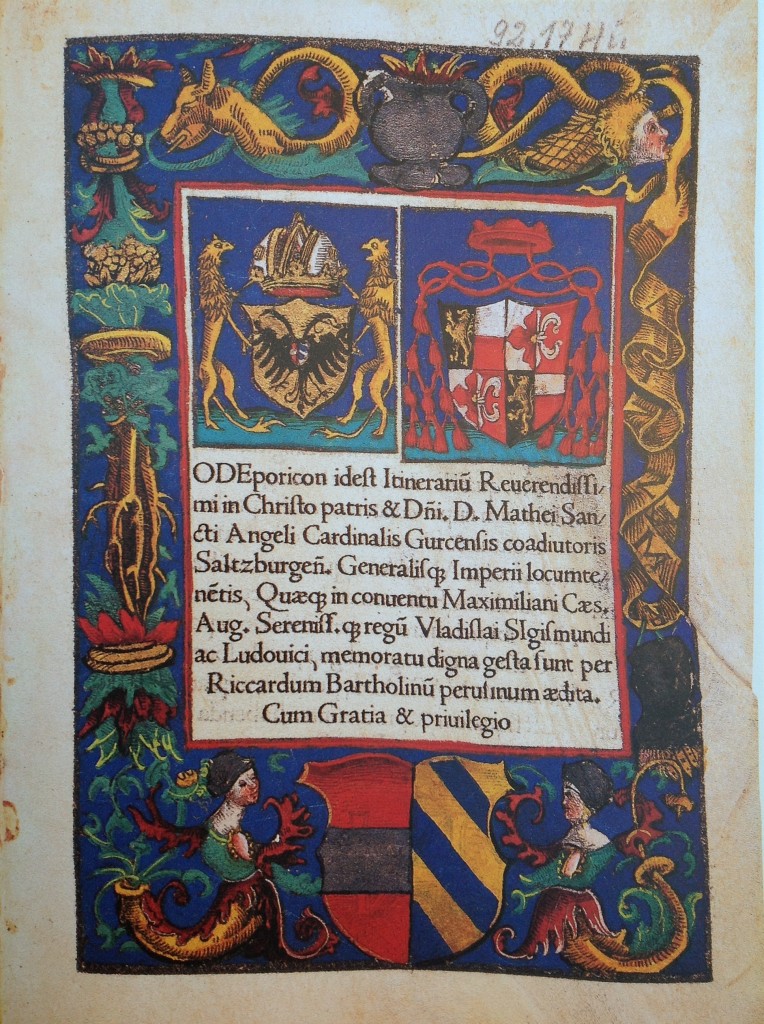
Riccardus Bartholinus (1470-1529) of Perugia was poet and humanist in the court of Holy Roman Emperor Maximilian I (1459-1519) in Vienna and legate as well as a professor of oratory at Perugia. His mythologically-rich travel report Odeporicon – laden with Virgilian and Pindaric allusions – was an itinerary of literary history. [6] The above plate shows at left the Austrian heraldry of Maximilian on the left with its shield blazon of the black double-headed eagle guarded by gold standing lions and surmounted by the imperial crown; on the right is the heraldry of Mathaus Lang of Salzburg, whom Bartholinus accompanied and for whom he was chaplain from 1513-19, surmounted by the familiar Cardinal’s red hat and cord. Lang’s blazon is also sub-quartered with the Austrian Habsburg colors of red and white. Note below the tarnished silver in the middle bar in place of white in the familiar Austrian and eventual Habsburg shield. Alongside the river entrance to old Feldkirch in the Vorarlberg of western Austria is a castellated tower with the same now-faded Habsburg colors of red white red in triple fess that have been adopted as the state flag of Austria, a landmark I frequently see in the Rhine Valley.
The top illustration from The British Library collections is a circa 1410 manuscript (Ms. Harley 4431) on the works of Christine de Pizan. The British Library ms. Harley 4431 celebrates Christine de Pizan’s writing with illustrations from 1410-14 as created for Queen Isabeau of Bavaria. Penned in Gothic cursive, its illustrations are variously attributed to either the workshop of the Master of the Duke of Bedford [7] or the Master of the Cité des Dames, a collection of Christine de Pizan’s work. Its heraldic imagery of the legendary myth persona of Queen Penthesilea, Queen of the Amazons and Trojan War opponent of Achilles (folio 103 verso), here in ‘L’Épître Othéa’ is imaginary in its replication of her crowned bust on shield and horse caparison on blue.
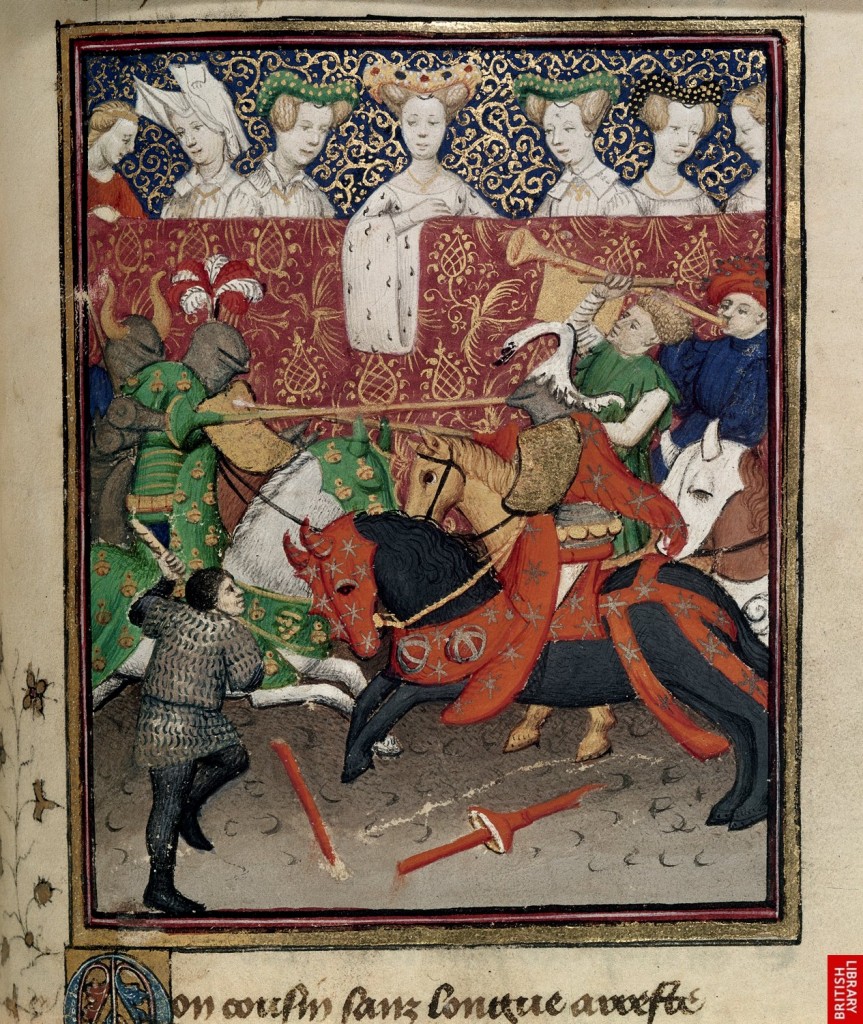
The Harley ms 4431 jousting scenes are more typical of an expected tournament with many-hued heraldic pageantry. One of them (folio 150) under the watchful gaze of noble women, the combatant on the right mantled in red with metallic stars and orbs, his helm crowned with a white swan, the combatant on the left mantled in green but with indistinguishable gold motifs, possibly small spherical bells. The other jousting scene is a a colorful melée– not at all certain as belonging to this manuscript collection, although its cursive Gothic and framing are nearly identical and may be written by the same scribe even if the artist is not the same. Its jousting contains a group of knights, one combatant with a red and yellow chequy (“checky”) heraldry, another combatant with a blue lion rampant on a yellow shield, yet another combatant with a yellow eagle on a red shield. In the background, five combatants display from left to right respectively upper black and lower white fess with lion guardant, reversed colors and an orange and white bendy dexter, a black and orange bendy dexter and a black and red pale heraldry.
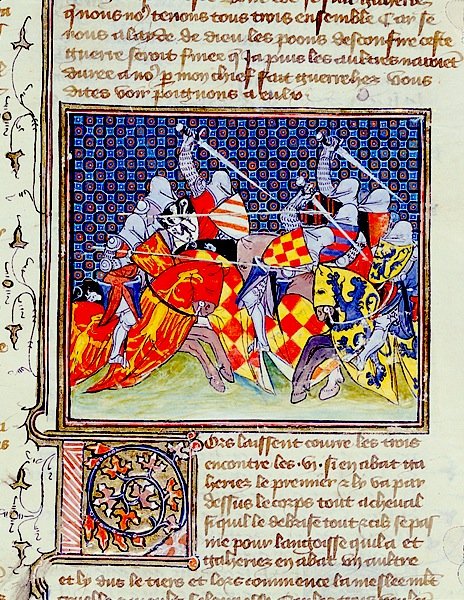
In an illustrated German Turnierbuch (Tournament Book) of around 1561, various scenes of jousting combatants in parade show elaborate heraldry. Below is a pair of jousters for the Hohenzeuggestech. To the left is Berthold Volkamer, and his heraldry is described as Per fess, in chief Argent, a half wheel Gules, in base Azure, a Fleur-de-lis Argent: “A shield Horizontally divided in half, upper is silver with a red half wheel, lower is a blue half shield with a silver fleur-de-lis.” His helmet is surmounted by a red half wheel with a black plume. On the right is Lamprecht Gross, and his heraldry is described as Argent, on a Mont Vert a Crosslet Gules surmounted by a Linden Tree proper: “Silver shield, a red crosslet and above it a naturally colored Linden Tree.” His helmet bears horns with green linden leaves. Both of the riders have smaller repetitions of their heraldic blazon on their horse caparisons. [8]
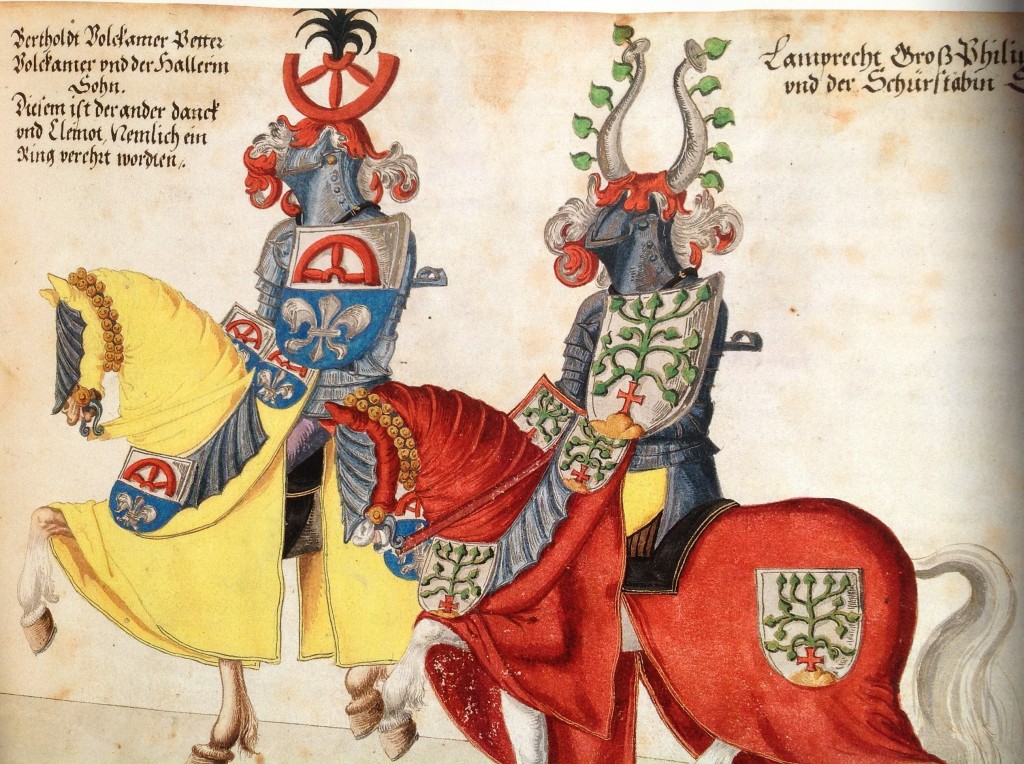
Also from the same Nuremberg manuscript, here below is a pair of Gemeine Gestech combatants, Balthasar Gugel and Endres [Andreas] Schmidmer. On the left, Gugel is depicted in his heraldry thus: Or, a bend Azure charged with Three Fleur-de-lis: In gold a blue diagonal stripe with three fleur-de-lis. His helmet is surmounted by blue and gold ribbons and gold fleur-de-lis (above which is the text date if 1561). On the right, Schmidmer is depicted in his heraldry as: Per pale Or and Gules with charged Owl Argent on Twig Vert: shield vertically halved in gold and red with a silver owl charge in the middle. His helmet is decorated with a red and gold entwined ribbon and a red and gold rose floret above. Their lances are also entwined with their same colors.
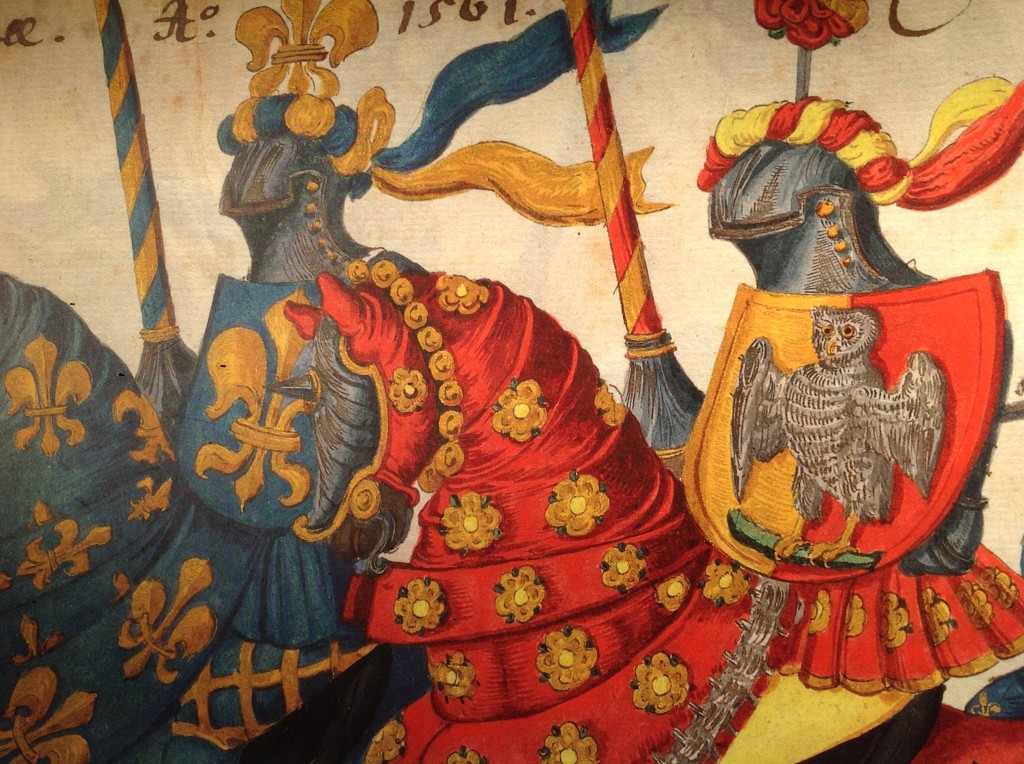
This private collection seventeenth (possibly nineteenth?) century green and gold stained glass roundel was purchased in Luzern, Switzerland in 1994. The Mühlebach family motto on it reads Oro honor in hoc mihi. Centrally-knotted fleur-de-lis motifs are quartered in green and gold and the helm is elaborated with green and gold plumes and lambrequin.
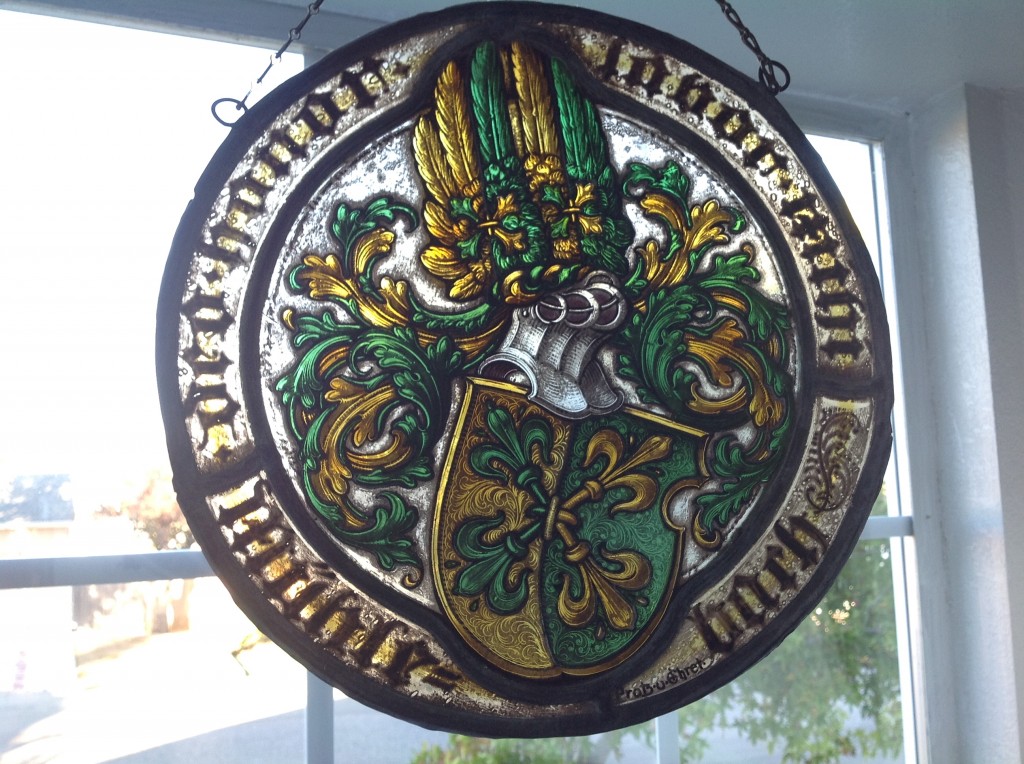
Historical fiction grounded in documented chronicles is satisfying when the author tells a story well without distorting facts. Such is Bernard Cornwell’s Azincourt, exceptionally well-written around the famous battle (also known as Agincourt) between the English and French in 1415. Protagonist English longbowman Nick Hook watches events unfold:
“Over his [Ghillebert, Lord of Lanferelle] armor he wore a bright surcoat that showed a golden sun from which rays snaked and shot and on the bright sun was an eagle’s head…” [9]
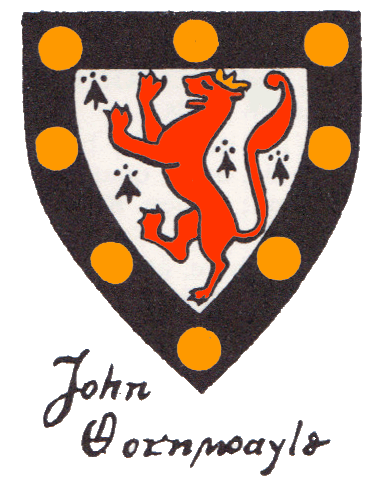
Elsewhere Cornwell describes a surcoat of three hawks on a green field for Sir Roger Pallaire, a fictional traitor Hook kills, and also describes a rider wearing the French royal heraldry of golden lilies (fleur-de-lis) on a blue field surrounded by a red border with white dots as well as wearing a gold coronet, historically the heraldry of the Duke of Bourbon, who has a role in the book. Sir John Cornewaille is another known historical figure in the book and his heraldry is also accurate, with a red rampant lion on a white field, crowned with a gold crown (lion rampant gules crowned) and with a gold star at its shoulder, known from both Agincourt and the Siege of Rouen in 1418. [10] Such detail demonstrates the author’s careful research for his acclaimed novel about Azincourt, one of the most important battles in history.
Overall, medieval heraldry – with a sumptuously complex visual language of its own – confirms the aesthetic sensibility of readers and visual audiences regardless of their textual literacy; as such heraldry’s brilliant use of color and embellished motif speak to a highly refined expression of culture before the advent of the printing press, whose rise many have lamented brought the death not only of handiwork in manuscripts but also of a whole art form of illumination. That the Nuremberg Turnierbuch is created after the printing press – 1561 is almost a century after the fact -hints that such hand-produced art was not only still in vogue but fulfilled historic needs. In black and white or hand-tinted, the mass production intent of the printing press could hardly compete with the incredible range of colors and quality of illustration of medieval heraldry. But the expense and time and energy demands of handmade manuscripts could only be afforded and justified by the very wealthy who could continue to pay for the extravagance of medieval illumination in high quality rather than quantity.
Notes:
[1] Chretien de Troyes. Erec and Enide. circa 1170. Burton Raffel, tr. Yale University Press, 1997. Chretien has often been suggested, first by Gaston Paris, as being herald-at-arms at the court of Marie of France, Countess of Champagne and daughter of Eleanor of Aquitaine.
[2] Arthur Charles Fox-Davies. A Complete Guide to Heraldry. Nelson, 1925 (republished by Skyhorse Publishing, 2007) introduction, v-vii.
[3] Huw Pryce, ed. Literacy in Medieval Irish Societies. Cambridge University Press, 1998, 109. Certainly between the 9th and 12th centuries this was the case.
[4] Alfred Burns. “Athenian Literacy in the Fifth Century BC.” Journal of the History of Ideas 42.3 (1981) 372-87, esp. 354, 384.
[5] Stephen Friar and John Ferguson. Basic Heraldry. Bramley Books / Quadrillion Publishing Ltd, 1999, 9.
[6] Stephen Füssell. The Theuerdank of 1517: Emperor Maximilian and the Media of His Day. Cologne: Taschen, 2003, 28-9.
[7] Eleanor R. Spencer. “The Master of the Duke of Bedford: The Bedford Hours”. The Burlington Magazine 107-751 (1965) 495-502.
[8] Helmut Nickel and Dirk H. Breiding. “A Book of Tournaments and Parades from Nuremberg.” Metropolitan Museum Journal 45 (2010) 145-46. The events pictured in the book range in date from 1446 to 1561.
[9] Bernard Cornwell. Azincourt. London: Harper-Collins, 2008, 80.
[10] ibid., 107, 436.